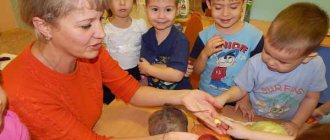Implementation of a person-centered approach in the practice of education
Personally-oriented pedagogy means for a teacher not only the creation of a favorable atmosphere, but also a constant appeal to the subjective experience of the student as the experience of his own life activity. The main goal of person-centered education is to reveal the content of each child’s subjective experience, bring it into line with the current tasks of educational work, and on this basis initiate the process of self-education of the child.
How is this approach implemented in the specific conditions of the pedagogical process? The teacher pays special attention to the integration of each student's unique and inimitable subjective experience with real-life activities. The correlation of socially significant and personally significant individual experience occurs in the interaction of the teacher and the child on the basis of balanced initiatives of the adult and the child as equal partners.
The implementation of person-centered education requires the teacher to comply with the following requirements:
- use a variety of methods, techniques, forms, ways of revealing the subjective experience of students, identifying their character traits, tastes, and views;
- rely as much as possible on independent activity, that is, not so much to direct as to organize and direct the activities of children
- involve children in independent or joint setting of educational goals, planning activities
- Encourage children to independently choose and practice socially acceptable behaviors.
- create situations of pedagogical communication in which each student can show initiative, independence and selective behavior
- Provide opportunities for students to express themselves naturally;
- encourage students to express themselves, analyze the motives and methods of their own behavior and the behavior of other students, and make value judgments at the appropriate age level;
- strive to encourage and evaluate not only actions, but also needs, motives, methods of activity, direction of activity and degree of independence.
- involve each child in a discussion of the goals and results of learning, successful steps, reasons for successes and failures, attitude towards the activity (what you wanted to repeat and what you wanted to do differently).
Understanding a child means penetrating into his inner spiritual world. Understanding is based on diagnosing the child’s personality and studying his experience and consists in the fact that the teacher creates on this basis a holistic picture of the child’s personality. Recognition of a child means the child’s right to be himself, the child’s right to respect from an adult. Recognition of a child means that the teacher maintains a balance between the child’s freedom of action, thinking and goal-setting and the reasonable demands placed on him by the teacher and society.
Acceptance of a child is a positive attitude towards him without any conditions on the part of parents and teachers. Accepting a child does not mean abandoning educational requirements, but presupposes such an attitude towards educational tasks and the choice of educational technology that best ensures the development of this particular child.
Characteristics of student-oriented technologies in education
One of the main features that distinguishes all educational technologies is the degree of their focus on the child, their approach to him. Either technology is based on the power of pedagogy, environment and other factors, or it recognizes the child as the main actor - it is person-centered.
The term “approach” is more precise and understandable: it has practical meaning. The term “orientation” reflects a predominantly ideological aspect.
The focus of personality-oriented technologies is the unique, holistic personality of a teenager who strives for maximum realization of his capabilities (self-actualization), is open to new experiences and is able to make informed and responsible decisions in various life situations. The key words of student-oriented educational technologies are “development”, “personality”, “individuality”, “freedom”, “independence”, “creativity”.
Personality is the social essence of a person, the totality of his social qualities and characteristics that he develops throughout his life.
Development is a directed, natural change; through development a new quality is created.
Individuality is the unique originality of a phenomenon, a person; the opposite of ordinary, typical.
Creativity is the process by which a product can be created. Creativity comes from within man himself, from within, and is an expression of our entire existence.
Freedom is the absence of dependence.
Personality-oriented technologies try to find methods and means of teaching and upbringing that correspond to the individual characteristics of each child: they use psychodiagnostic techniques, change the attitudes and organization of children’s activities, use a variety of teaching tools, and rebuild the essence of education.
Personality-oriented technologies oppose the authoritarian, impersonal and soulless approach to the child in traditional pedagogical technologies, create an atmosphere of love, care, cooperation, conditions for creativity and personal self-realization.
But in order to work with each student individually, taking into account...
The entire educational process must be structured differently to take into account its psychological characteristics.
Technologization of the student-oriented educational process involves the special design of educational text, didactic material, methodological recommendations for its use, types of educational dialogue, forms of control over the student’s personal development in the process of acquiring knowledge. Only if there is didactic support that implements the principle of subjectivity in education, can we talk about building a student-oriented process.
In order for the person-centered approach to be in demand by teachers and accepted into mass practice in schools, a technological description of this process is necessary. Yakimanskaya I.S. defines the technology of student-centered learning as the principles of development of the educational process itself and makes certain requirements for texts, didactic materials, methodological recommendations, types of educational dialogue, forms of monitoring the student’s personal development, i.e. to the development of all didactic support for student-centered learning. These requirements are as follows:
- The educational material must reveal the content of the student’s subjective experience, including his previous learning experience; the presentation of knowledge in a textbook (by the teacher) should be aimed not only at expanding its volume, structuring, integration, generalization of subject content, but also at the constant transformation of the student’s existing subjective experience;
- In the learning process, it is necessary to constantly compare the student’s subjective experience with the scientific content of the knowledge given;
- active stimulation of the student to self-valued educational activities, the content and forms of which should provide the student with the opportunity for self-education, self-development, self-expression in the process of acquiring knowledge;
- Design and organize educational materials, allowing students to choose content, type and form when completing assignments and solving problems;
- Identify and evaluate learning pathways that students use independently, sustainably, and productively. The ability to choose a path should be included in the task itself. The textbook (teacher) should be used to encourage students to select and use basic ways of working through educational material;
- When metacognition is introduced, i.e. knowledge about the methods of carrying out educational activities, it is necessary to distinguish between general and specific (subject) teaching methods, taking into account their functions in personality development;
- it is necessary to control and evaluate not only the result, but first of all the learning process, i.e. those transformations that the student undergoes in the process of mastering the subject;
- The educational process must ensure the construction, implementation, reflection and evaluation of learning as a substantive activity. To do this, it is necessary to identify learning units, describe them, and use them to organize teaching by the teacher in the classroom, in individual work (various forms of correction, tutoring).


